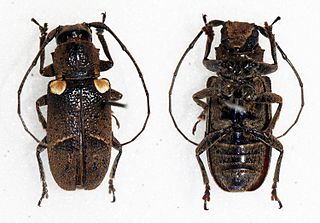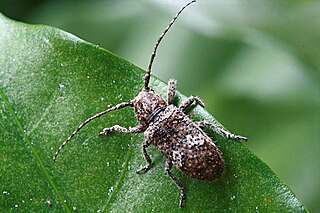
The Auxiliary Corps of the Black Shirts' Action Squads, most widely known as the Black Brigades, was one of the Fascist paramilitary groups, organized and run by the Republican Fascist Party operating in the Italian Social Republic, during the final years of World War II, and after the signing of the Italian Armistice in 1943. They were officially led by Alessandro Pavolini, former Minister of Culture of the fascist era during the last years of Fascist Italy.

Zaptié was the designation given to locally raised gendarmerie units in the Italian colonies of Tripolitania, Cyrenaica, Eritrea and Somaliland between 1888 and 1943.

Dubat ; Arabic:العمائم البيضاء ); ḍubbāṭ: English: White turban) was the designation given to members of the semi-regular armed bands employed by the Italian "Royal Corps of Colonial Troops" in Italian Somaliland from 1924 to 1941. The word dubat was derived from a Somali phrase meaning "white turban".

Oedipina uniformis is a species of salamander in the family Plethodontidae. It is found in mountains and lowlands of central Costa Rica to the Panamian border and likely to occur in Panama.

Nocardicin A is a monocyclic β-lactam antibiotic included in the monobactam subclass. It is obtained from the fermentation broth of a strain of actinomycetes Nocardia uniformis subsp. tsuyamenensis as a metabolic product catalyzed by the enzyme nocardicin-A epimerase. It is stereochemically and biologically related to penicillin and cephalosporins.

Cypa uniformis is a species of moth of the family Sphingidae. It is known from China, north-western India and Borneo.

The Royal Corps of Colonial Troops was a corps of the Royal Italian Army, in which all the Italian colonial troops were grouped until the end of World War II in North Africa campaign.

Prosoplus is a genus of longhorn beetles of the subfamily Lamiinae, containing the following species:

Sceloporus uniformis, also known as the yellow-backed spiny lizard, is a reptile of the family Phrynosomatidae. It is native to the Mojave and Great Basin deserts. Until recently, it was considered to be a subspecies of Sceloporus magister.
Prosoplus atlanticus is a species of beetle in the family Cerambycidae. It was described by Stephan von Breuning in 1938.
Prosoplus rugulosus is a species of beetle in the family Cerambycidae. It was described by Stephan von Breuning in 1938.
Prosoplus imitans is a species of beetle in the family Cerambycidae. It was described by Stephan von Breuning in 1961.

Rhytiphora bankii is a species of beetle in the family Cerambycidae. It was first described by Johan Christian Fabricius in 1775, under the genus Lamia. It is known from Australia, the Philippines, Borneo, Java, Micronesia, New Guinea, Hawaii, Moluccas, Sumatra, Vietnam, and has been introduced into Japan. The Australian species of Prosoplus were synonymised with Rhytiphora in 2013.
Prosoplus costatus is a species of beetle in the family Cerambycidae. It was described by Karl-Ernst Hüdepohl in 1996. It is known from Borneo and Malaysia.
Prosoplus dentatus is a species of beetle in the family Cerambycidae. It was described by Guillaume-Antoine Olivier in 1792. It is known from Mauritius, Seychelles, Réunion, and Madagascar. It contains the varietas Prosoplus dentatus var. ochreomaculatus.
Prosoplus kambangensis is a species of beetle in the family Cerambycidae. It was described by Stephan von Breuning and de Jong in 1941.
Prosoplus lividus is a species of beetle in the family Cerambycidae. It was described by Masaki Matsushita in 1935.
Prosoplus sinuatofasciatus is a species of beetle in the family Cerambycidae. It was described by Blanchard in 1855.
The Military ranks of the Kingdom of Italy were the military insignia used by the Italian Armed Forces when Italy was the Kingdom of Italy (1861–1946). During the World Wars, the Carabinieri, as the then-most senior corps of the Army, wore similar insignia to those used by the rest of the service.
The Military ranks of the Italian Social Republic were the military insignia used by the National Republican Army of the Italian Social Republic. The ranks were essentially the same as the military ranks of the Kingdom of Italy, however, with the symbols of the monarchy removed.









